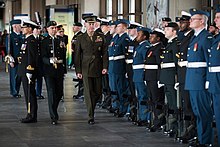Ceremonial Guard (Canada)
The Ceremonial Guard (CG; French: Garde de cérémonie) is an ad hoc military unit in the Canadian Armed Forces that performs the changing the guard ceremony on Parliament Hill and posts sentries at Rideau Hall, with the National War Memorial being sentried by the National Sentry Program (NSP), which is carried out by different regiments and other units in order of precedence throughout the summer until mid-November.
It conducted its first guard mount on Parliament Hill on 2 July 1959 in the presence of Queen Elizabeth II.
Beginning in the early 1970s, the CGG and the GGFG were added to the Public Duties Detachment (PDD) of the Canadian Guards, due to it being reduced to nil strength in 1970.
[1] The PDD, which had been based at CFB Rockcliffe until 1985, changed its name to the Ceremonial Guard in 1979, when the unit became mixed sex due to a compromise by the Department of National Defence as a result of a complaint to the Canadian Human Rights Commission on the matter that women could not join the guard due to its status as an infantry unit.
Musicians are drawn from military units and colleges or universities across Canada, and are auditioned months in advance.
All new musicians must pass the Canadian Armed Forces Basic Military Qualification Course (BMQ) before they can be employed with the Ceremonial Guard.
The parade begins at the Cartier Square Drill Hall with the drum major, followed by the band, and the two divisions of the "new guard".
The posting NCO, sentries, and escorts are all dressed in full scarlet uniforms and carry rifles with bayonets fixed.
The party marches to the Sussex Drive gate of Rideau Hall, where the first two sentries are posted and have their duties read to them.
The party then marches back to Rideau Hall itself, where the two remaining sentries are posted and have their duties read.
[citation needed] Throughout the day Rideau Hall is visited by the officer commanding of the parade and the company sergeant-major.
The officer and the guard sergeant for Rideau Hall may also elect to do rounds to check on both of the sentry posts.
[11] Corporal Nathan Cirillo, a 24-year-old reservist with the Argyll and Sutherland Highlanders of Canada, was standing guard as a ceremonial sentry at the National War Memorial when he was shot with a hunting rifle by Michael Joseph Zehaf-Bibeau.
[12] He then drove to Centre Block, and was subsequently killed in a firefight with Sergeant-at-Arms Kevin Vickers and RCMP Corporal Curtis Barrett.
[15] This inspection takes place prior to the first Guard mount on Parliament Hill normally in late June, the Canada Day celebration (specifically the noon show) on 1 July, the "Fortissimo" Sunset Ceremony that takes place in late July or early August on Parliament Hill, and the Guard's final parade, Trooping the Colour, at the end of August.
In between their turns, alongside the regiments forming up the Ceremonial Guard, the Ontario and Quebec area personnel from the Army Primary Reserve regiments stationed in their respective provinces, alongside those from other provinces of the country, handle the guard changing duties only at the National War Memorial, reinforced by the Canadian Rangers and the Royal Canadian Mounted Police, as part of the aforementioned National Sentry Program of the Canadian Armed Forces.






